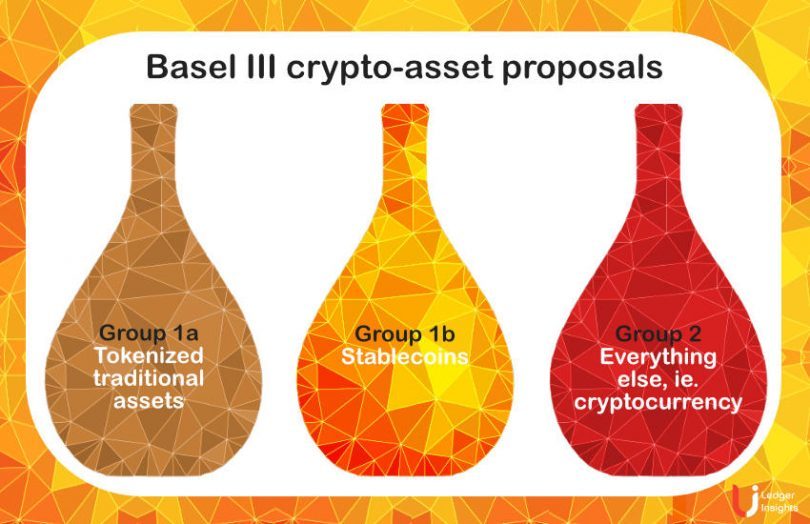(Dinarian Note: Click on the 1st link and you can read all the submissions from companies, Here is RIPPLES. Mind you, this is a startup company in San Fransisco writing to the Bank Of International Settlements, and YES XRP IS MENTIONED!)
The second crypto-asset consultation by the Basel Committee for Banking Supervision closed at the end of September and it published the feedback received. One of the proposed rules limits the amount of bank cryptocurrency exposures to 1% of Tier 1 bank capital. Some of the feedback concluded that means that most of the world’s largest banks can have a combined $20 billion exposure to crypto-assets.
The four most restrictive proposed Basel rules
There’s a lot of detail in the proposed Basel rules, but the four most significant issues are:
- Cryptocurrency exposures require a dollar-for-dollar set aside of tier 1 capital by banks
- Total cryptocurrency exposures are limited to 1% of Tier 1 capital
- DLT use for traditional assets attracts a 2.5% surcharge
- Cryptocurrency custody also has a dollar-for-dollar capital requirement.
We previously summarized the joint feedback from major trade associations.
Cryptocurrency exposure limit
The combined Tier 1 capital of 21 of the 30 globally systemically important banks (G-SIBs) – excluding nine banks in China, Japan and Switzerland – totals $2 trillion, limiting their combined Group 2 crypto-asset (crytocurrencies) exposure to $20 billion. The crypto market is currently worth more than $950 billion. So together, the banks could have a maximum exposure of 2% to the whole cryptocurrency market.
The CME made a similar calculation, concluding that all its CME Clearing bank member firms could have a combined exposure of $20 billion.
Group 2 crypto-assets have a 1250% risk weighting, which means that banks have to set aside a dollar of capital for every dollar of cryptocurrency exposure. Although some hedging is now accounted for (up to 65%), in the absence of a cap, this would already disincentivize bank exposures.
Societe Generale observed that this “risks cementing control of these markets to non-banking players through excessively burdensome requirements.”
The World Federation of Exchanges and the Deutsche Börse had similar sentiments. “The proposed methodology has no precedent in financial market regulation when comparing it to other economically more volatile and less predictable asset classes (such as other complex financial instruments),” wrote the Deutsche Börse. “Exposure limits on individual asset classes for banks have to the best of our knowledge not even been proposed during the 2008 global financial crisis.”
A few large crypto exchanges also provided responses and they too objected to the cap, despite banks potentially being competition. Institutional adoption is viewed by many as a critical path to crypto-assets becoming mainstream.
Same activity, same risk, same treatment?
As much as the Tier 1 cap on cryptocurrencies was universally slated, so was the 2.5% infrastructure risk addon for Group 1 assets, which covers tokenized traditional assets and extremely conservative stablecoins.
“It is contradictory with the general ‘same activity, same risk, same treatment’ principle, acknowledged by the BCBS, especially for assets belonging to group 1a (tokenized traditional assets),” wrote BNP Paribas.
Societe Generale characterized it as “excessively conservative and lacks evidence-based justification. The use of DLT could lower the level of operational risks in institutions.”
Talking about the 2.5% surcharge on tokenizing conventional assets, the German Banking Industry Committee wrote, “there is a risk that this activity could move from the regulated financial sector to less regulated or completely unregulated sectors. This cannot be intended by the Basel Committee.”
The 2.5% addon “sets a precedent for applying capital penalties for the introduction of new technologies,” wrote the CME, which characterized it as a tax. “The stated aim of the FSB, International Organization of Securities Commissions (IOSCO) and the BCBS is to achieve a technology-neutral approach to cryptoasset regulation.”
The Deutsche Börse also pointed to the lack of technology neutrality regarding whether the blockchain infrastructure is permissioned or permissionless, because the Basel rules strongly favor permissioned DLT.
Additional burdens on activities that are already regulated
Different types of regulated institutions complained that they are already subject to prudential regulation and hence shouldn’t have additional burdens imposed.
For example, both the CME and CBOE stated that centrally cleared derivatives should be excluded from the 1% of Tier 1 capital exposure limits.
Fnality, the DLT-based payments infrastructure, believes that the 2.5% DLT addon for tokenized conventional assets should not apply as it already complies with the Principles of Financial Market Infrastructures.
The World Federation of Exchanges asked for crypto-assets traded on regulated exchanges to be treated the same as their traditional counterparts. This especially relates to the 2.5% DLT addon, “particularly when the DLT is managed by an authorised exchange/CCP, which must and does take into account such risks.”
Crypto custody on the balance sheet
In April, the SEC imposed a new accounting rule, requiring crypto-asset custodians to put the assets they custody on their balance sheet. Normally assets owned by the banks’ clients don’t touch the balance sheet. The rule means that for every dollar of cryptocurrency under custody, a bank has to set aside a dollar of capital, which is not a viable business model. State Street described the rule as ‘insane’. The major custodians have all objected to the rule.
As an example, at the end of June 2022, BNY Mellon, the world’s largest conventional custodian, had assets under custody of $43 trillion with $21.8 billion of Tier 1 capital.
Hence such a rule essentially blocks conventional custodians from participating in cryptocurrency custody beyond a tiny scale.
The first Basel proposal did not take account of custodied assets. But the second proposal published in June stated that crypto-asset exposures also apply to “activities, such as nonfiduciary custodial services, that may only give rise to operational risk.”
The Association of Global Custodians wrote, “Our members do not believe that it’s appropriate for the Committee to use the Second Consultation to redefine the current understanding of the term ‘exposure’ to include assets held in custody.” The American Bankers Association concurred.
Three of the world’s largest conventional custodians, BNY Mellon, State Street and Northern Trust, wrote a combined letter objecting to this, as well as the 2.5% DLT addon for conventional assets and the 1% Tier 1 cap.
Stablecoins and basis risk
There was a fair amount of feedback about stablecoins.
Our reading of the proposal is that tokenized bank deposits are considered Group 1a traditional assets as opposed to 1b stablecoins. Stablecoin issuer Circle seemed to think the same, but BNP Paribas asked for explicit clarification.
The proposed Basel rules include some fairly burdensome tests on stablecoins, so it’s unlikely that any current stablecoins would be considered Group 1. Failing that, they become Group 2 with its 1250% risk weighting or dollar-for-dollar capital requirement.
The first test relates to the ability of a user to redeem a stablecoin, and the second is for basis risk. That considers how often a stablecoin has lost its peg recently using a conservative 20 basis points.
Given banks are already prudentially regulated, BNP Paribas believes these tests should not apply to bank-issued stablecoins. The Basel proposals already state that to qualify as Group 1b, a stablecoin has to have a supervisor that imposes prudential capital and liquidity requirements. The proposals state that the Basel Committee is considering replacing the two tests with this supervision requirement.
FTX US made the logical point that if a stablecoin passes the redemption test, then the basis test is irrelevant because a user can redeem the stablecoin if the peg is lost. The redemption risk test is meant to work even in a crisis situation. However, regulators would probably argue that they are intentionally being prudent.
Stablecoin issuer Circle argued that its stablecoin is fully backed by cash and cash equivalents and hence “has reserve holdings that are safer than tokenised deposits, which the BCBS classifies as Group 1a”. It wants to see safely backed stablecoins treated the same as tokenized deposits.
Overall the feedback was more or less consistent in asking for more relaxed rules. The second round of proposals was in some ways more accommodating but considerably more restrictive in other significant aspects.
Shortly before the second consultation round started, the Chair of the Basel Committee Pablo Hernández de Cos, said, “diluting bank capital requirements because of a fear that crypto-asset activities will migrate outside the regulated banking system is not a convincing argument.”



























